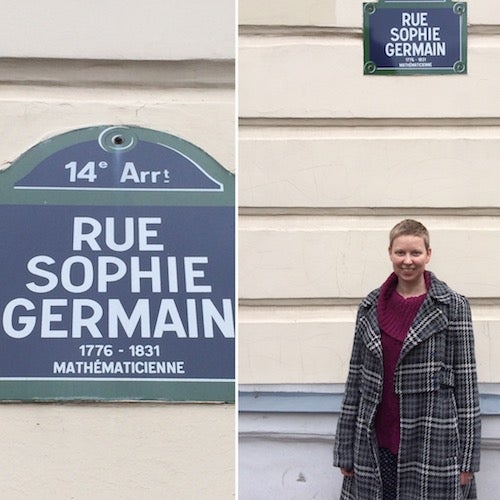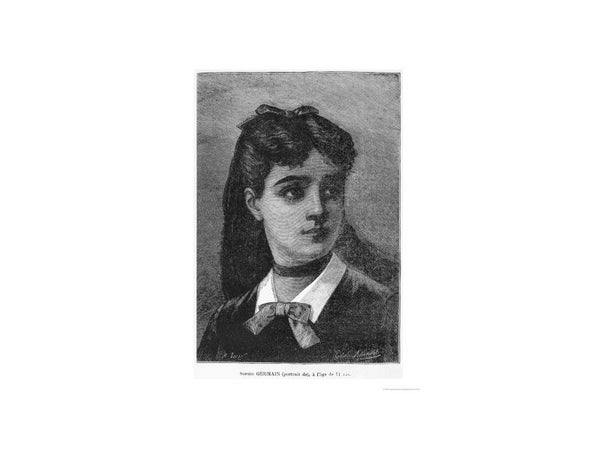This article was published in Scientific American’s former blog network and reflects the views of the author, not necessarily those of Scientific American
Of the nearly 100 streets in Paris named after mathematicians, only one* is named for a woman. So on March 8, International Women’s Day, I walked over to Rue Sophie Germain to pay my respects.

Credit: Jon Chaika and Evelyn Lamb
Sophie Germain, born on this day, April 1st, in 1776, was a French mathematician. Though it is impossible to know with 100 percent certainty, she was probably the first woman to make significant original contributions to mathematical research. But when I think of her, my admiration is mixed with a profound sense of loss.
On supporting science journalism
If you're enjoying this article, consider supporting our award-winning journalism by subscribing. By purchasing a subscription you are helping to ensure the future of impactful stories about the discoveries and ideas shaping our world today.
Germain fell in love with mathematics when she was a teenager. The story goes that she had to stay indoors because of the French revolution. In her hours of reading, she found a biography of Archimedes in her father’s library. His dramatic (and probably embellished) death scene, in which he is killed by a Roman soldier because he would not stop working on a math problem, captured her imagination. She showed a natural inclination, and though her parents tried to discourage her, she persisted in teaching herself a great deal of math.
Women were not allowed at universities in France at the time, but Germain corresponded with professors at the newly-opened École Polytechnique using the name of Monsieur Antoine-August LeBlanc, a former student. When she eventually revealed her true identity to some of them, she was accepted more than she expected to be but never truly treated as a peer.
Throughout her life, Germain’s lack of a comprehensive formal education in math and isolation from mathematical and scientific society held her back. In their book Sophie Germain: An Essay in the History of the Theory of Elasticity, Louis L. Bucciarelli and Nancy Dworsky write,
The plate equation, her final result, met our expectations, but her analysis was inadequate, and must have appeared so to her contemporaries who awarded the prize. Her deficiencies were due, in part, to a lack of sophistication in arguing her basic hypothesis, in part to neglect in establishing the consistency of an approximation made in the course of her derivation, and in part — most surprisingly — to failure in certain basic technical skills. Her grammar, so to speak, was deficient; she could not spell.
It is hard to imagine that the talents of a male student with the same enthusiasm and aptitude for mathematics would have been left so underdeveloped.
Germain also worked in the field of number theory, attempting to prove Fermat’s Last Theorem. The statement of the theorem is that there are no solutions to the equation xn+yn=zn where x, y, and z are positive whole numbers other than 0 and n is a whole number greater than 2. She was credited with a theorem about divisibility conditions for numbers satisfying Fermat’s equation, but a few years ago, Reinhard Laubenbacher and David Pengelley discovered that her research went much deeper and that she had an ambitious plan to prove the theorem. The plan didn't work, and it couldn't have, but it reveals previously unknown depths to her mathematical thinking. Julie Rehmeyer wrote two excellent articles about Germain’s approach to Fermat’s Last Theorem for Science News (Part I, Part II). The article about her work by Reinhard Laubenbacher and David Pengelley is also a good read, though it gets fairly technical in some parts.
Reading about Germain’s life and work, I am torn. I am in awe of her enthusiasm, creativity, and intellect. I am grateful for her persistent spirit because the persistence of women like her helped make my life possible. But so much of her story is a story of what could have been. If she had had access to the same opportunities as men, she could have explored her exciting ideas more fully in the company of other researchers whose suggestions would have helped her flourish. I wish I could be reading that story rather than this one.
Germain is one of the first women who made original contributions to mathematics, but she was not one of the first women with significant mathematical talent. Germain was born into a well-off family with access to books about math. She did not have to work in someone else’s home as a poorer woman may have, and she never married, which at the time would most likely have made it impossible to continue studying. How many other women were there who had the same talent and curiosity but could not pursue mathematics to the degree Germain did? When I read her story, I mourn not only for the contributions she could have made if she had not faced so many barriers, but for the thousands of women we never heard from at all. As much opposition as Germain faced, they faced more.
Germain died of breast cancer in 1831 when she was 55 years old. It feels like a cruel irony that after a lifetime of discrimination because of her sex, she was in the end betrayed by the very body parts that discrimination was based on. I’m sorry, Sophie, that the world was not ready to recognize or nurture your genius. I’m sorry you were never Professor Germain. I’m sorry that medicine could not heal you or ease your pain at the end. And I’m sorry for the thousands of other women just as bright as you who never got to share their gifts with the world.
*A few days after I wrote this post, I stumbled on another Paris street named after a woman mathematician. Read about it here.
